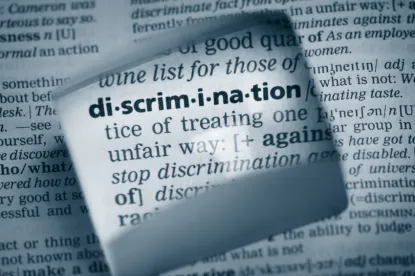We all know (or should know) that Title VII of the Civil Rights Act and other discrimination laws prohibit intentional discrimination “because of” protected characteristics like race, age, gender, or disability. We can easily imagine instances of intentional discrimination—a sexist manager refusing to hire female applicants, a racist boss refusing to promote qualified African Americans, and the list goes on.
Many employers do not realize, however, that Title VII liability extends beyond such overt acts to more subtle discrimination. Indeed, the Equal Employment Opportunity Commission (EEOC), and the courts view employment decisions as made “because of” protected traits even absent an explicit intent to discriminate, if they disparately impact a protected group. Under a court’s “disparate impact” or “adverse impact” analysis, a plaintiff can prevail in a lawsuit by establishing an employer’s policy or practice affects members of the protected group so disproportionately that the court can infer discrimination from that impact.
The original Supreme Court disparate impact case of Griggs v. Duke Power Co., 401 U.S. 424 (1971), found a North Carolina employer’s high school degree and aptitude testing requirements for certain higher-paying departments unlawful because of their lopsided effects on African Americans. The plaintiff did not present any evidence that the company intended to discriminate against African Americans. In fact, the company employed 13 of the plaintiffs in another, lower-paying department. Because of segregation and other systemic societal issues, however, only 12 percent of African American males in North Carolina held high school degrees at the time, compared to 34 percent of white males. Similarly, only 6 percent of African Americans passed the aptitude tests used by the company, compared to 58 percent of whites.
The Court found no relationship between the jobs at issue and the degree and aptitude tests. In other words, a high-school education and passing an aptitude test did not correlate to success on the job. As a result, the Court found the screening measures discriminatory under a disparate impact theory. Chief Justice Berger likened the company’s requirements to “the fabled offer of milk to the stork and the fox,” in vessels that the other could not use (e.g., a narrow-necked jug for the fox). The company opened these positions, the Court found, to African Americans, but only if they possessed irrelevant qualifications that they disproportionately lacked.
Griggs addressed important issues of discrimination arising from social and historical factors, but it also highlighted difficult legal questions that employers, employees, the courts, and the EEOC continue to grapple with today.
How Courts Analyze Disparate Impact Claims
When does a disparate impact exist? The answer generally lies in statistics. The EEOC often relies on the “four-fifths rule of thumb” according to which a “selection rate” for a protected group of less than four-fifths (or 80 percent) of the most successful group’s selection rate is considered evidence of discrimination.
Applying that test to the high school diploma requirement in Griggs, a disparate impact is shown by dividing the percentage of African American males who held high school diplomas (12 percent) by the percentage of white males with diplomas (34 percent), resulting in 35.3 percent (less than half of the 80 percent threshold).
Since the test requires dividing one percentage by another percentage, it has been referred to as a “ratio of ratios.” For example, if a height requirement left 6 out of 10 otherwise qualified female applicants eligible for a promotion, while also leaving 16 out of 20 otherwise qualified male applicants eligible, the ultimate disparate impact ratio would be calculated as 6/10 divided by 16/20 (60 percent divided by 80 percent = 75 percent).
Courts have widely approved of the four-fifths rule of thumb, while also cautioning that it should not be applied mechanically. Some courts, relying on a Supreme Court case evaluating racial bias in jury selections, have also applied statistical methods measuring “statistical significance” (two or more “standard deviations” from the “expected mean”). These methods are more complex than the “four-fifth rule,” but essentially focus on the difference between reality and the statistically probable result in the absence of discriminatory practices.
Regardless of which statistical method is used to calculate disparate impact, the legal effect is the same. If a statistical disparate impact can be shown, then the court draws an “inference of discrimination.”
Business Justification: It’s Not All About the Numbers
The “inference of discrimination” is not sufficient for a plaintiff to prove his or her case. Once a plaintiff shows an inference of discrimination, an employer then may “rebut” that showing by explaining that its policy or practice has a legitimate business justification. A valid business justification must “serve[], in a significant way, the legitimate employment goals of the employer.” The employer in Griggs, for example, would have possessed a valid business justification if high school diplomas or aptitude tests were truly necessary for employees to perform the work at issue.
Once an employer articulates a business necessity, the plaintiff can still prevail by showing other policies or practices would be at least as effective at meeting the stated business interests as the chosen practice, but would also have less of an impact on the protected group. Such a showing satisfies the plaintiff’s ultimate burden of proof—and leads to liability for the employer under a disparate impact theory.
What Employers Can Do to Avoid Disparate Impact Claims
The prospect of being accused of unlawful discrimination, despite having no intent to discriminate, is daunting for any employer—especially since disparate impact claims can be quite costly because they generally implicate large classes of individuals and are oftentimes brought by the federal government (specifically, the EEOC). Here are a few ways that employers can help keep these types of allegations at bay.
-
Employers may want to ensure that all of their job requirements, policies, and selection processes relate to business or operational goals.
-
Employers can consider recruiting employees from a diverse set of sources and opening promotional opportunities to a wide variety of applicants.
-
Employers may want to consider utilizing quantifiable hiring and promotional tools, such as scorecards rating applicants on job-specific competencies.
-
Look around: If an employer notices its workforce lacks diversity in a particular characteristic, the employer may want to ask itself whether the reason could be any of its policies or practices.
These common sense steps can help avoid an unexpected—and expensive—claim that an employer unintentionally (but illegally) discriminated against a protected group of people.





 />i
/>i

